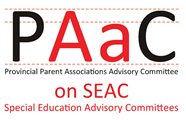In Regulation 464/97, Section (1) a “local association” is defined as:
“an association or organization of parents that operates locally within the area of jurisdiction of a board and that is affiliated with an association or organization that is not an association or organization of professional educators but that is incorporated and operates throughout Ontario to further the interests and well being of one or more groups of exceptional children or adults.”
There are three key concepts in this definition.
- The local association of parents must operate locally within the school board jurisdiction.
- The local association must be affiliated with an incorporated provincial organization that works on behalf of one or more group of exceptional students.
- The local or provincial association cannot be an association or organization of professional educators.
The Ministry of Education document, Special Education: A Guide for Educators (2001) provides school boards with further guidelines (not in the regulation). In Part A, Subsection, Advisory Committees on Special Education, page A27, it states:
- The SEAC seats for representatives of local associations should be used to bring to the committee the perspective of parents of children with a wide range of exceptionalities. Note that the ministry provides school boards with definitions of exceptionalities for use in the identification, placement, and review process. As many as possible of these exceptionalities should be represented on the SEAC.
- Representatives of local associations should be persons who can express the concerns of the parents of the exceptional pupils of the board.
- Representatives of local associations should bring the perspective and resources of a provincial or a national association that is incorporated and that operates throughout Ontario to further the interests of one or more groups of exceptional pupils.
- The representative of the local association nominated by the association is normally the person appointed by the board.
As long as the association selects as its representative a member who lives within the jurisdiction of the board, the actual address of the “branch” of the association should not be significant.
Effective Practices to identify qualified local associations include:
- Finding out the names and contact information for provincial associations that represent the interests of exceptional students from the PAAC on SEAC website or on the Ministry of Education Website.
- Contacting provincial parent associations to identify local groups or chapters within the school board boundaries and/or to request nomination of eligible members of local associations or chapters.
- Maintaining an up-to-date list of local organizations that provide support to families of exceptional children or adults.
The maximum number of local association representatives that can be appointed is 12 (Regulation 464/97, Section 2 (2)) and in many school board jurisdictions there are many more than 12 eligible local associations.
Effective Practices for when a school board has received more than 12 nominations for appointment as local association representatives include:
- Selecting from within the list of nominees to ensure that there is a representative for each of the exceptionalities.
- Asking representatives from similar groups, who represent the same group(s) of exceptional children or adults, to consider working together and nominating a single representative.
- Developing a policy or process to allow additional associations to be nominated to SEAC when a vacancy occurs within the four year term of SEAC.
In some areas of the province SEACs have had difficulty recruiting SEAC members who represent local associations. These SEACs may have to try new strategies to attract nominees.
Regulation 464/97 (Section 3 (2)) addresses the situation where there are no local associations and permits a board to appoint two members and two alternates who are not members of the board. For additional strategies see Section 2.4 regarding additional members of SEAC.
